Bassett’s Blog: Playing with the King
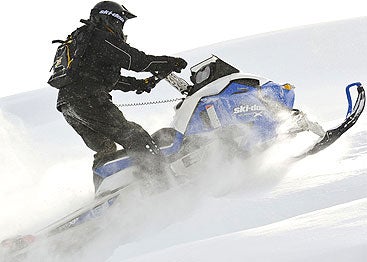
Powder play gets serious for 2009
Let’s face it; those of us living in the flatlands don’t really get ‘mountain’ sleds. Years ago, most mountain machines were pretty much standard flatland sleds with longer tracks and a manufacturer’s biggest engine.
Those ‘years ago’ were when powder sleds only accounted for about 10-12 percent of the snowmobile industry’s sales. Then in the late 1990s, after about six years of real dismal snowfall in the flatlands, which equated to real dismal sales of flatland sleds, the snowmobile manufacturers starting getting serious about following the money. The money in snowmobiling was out west.
Even though many western areas were suffering through lower than normal snowfalls, there was still plentiful snow for riding. There were people buying snowmobiles and these people were pretty picky – and demanding. They wanted – demanded – lighter and lighter sleds with more and more powerful engines. Recognizing that their western snowmobile dealers were selling sleds at a healthy clip, the manufacturers stepped up. Model year 2009 may be the peak of mountain sled evolution as Polaris, Arctic Cat and Ski-Doo offer their most lightweight, powerful models to date.
If you’ll notice, powder players prefer 2-stroke power. They want the lightest, largest displacement, most powerful motors they can get. For now, despite Yamaha’s constant reworking of its 4-stroke mountain machines, 2-stroke power remains king of the hill for serious highmarkers.
Weighty Certification
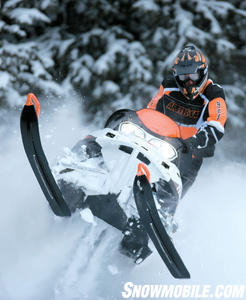 Lighter weight makes the 2009 M-Series a solid choice for Cat fans.
Lighter weight makes the 2009 M-Series a solid choice for Cat fans.
How serious are the 2-stroke mountain sled makers? Arctic Cat will certify the weights of its 2009 mountain sleds.
“If a customer shows that his sled’s weight is more than five pounds off the certified weight, he’ll get $500,” stated an Arctic Cat spokesman at the Grand Lake, Colo. test rides this past March. Of course, the customer’s M-series sled has to be weighed in accordance to the same procedures as the factory’s certified model. Cat is serious about setting apples to apples weight comparisons for all mountain snowmobiles.
Arctic Cat engineers worked hard at shaving weight from its 2009 M-series models. For example, although Arctic Cat added a nifty new telescoping steering column, Cat’s engineering staff quickly pointed out that the 8-10ths of a pound gain is actually lighter than if you added a 3-inch riser block.
According to Cat’s engineers, the 2009 M-Series is more than 20 pounds lighter than previous versions. Using Cat’s new push-button electronic reverse accounted for 8-lbs. The revised tunnel design is 4-lbs lighter. The skidframe is lighter and Cat states simply that the new design is comparable with those available in the aftermarket. The front suspension is lighter. Lighter weight shocks are used. Whatever could be lightened without reducing reliability and durability was lightened.
Of course, wouldn’t you expect Arctic Cat to take this deep powder riding seriously? Part of the test team consists of veteran powder riders, many of whom either currently or were regulars on the western hillclimbing and racing circuits. Arctic Cat’s western racers don’t just race for trophies; they also race to improve Arctic Cat’s M-Series. Hey, these guys like to highmark with their buddies, too!
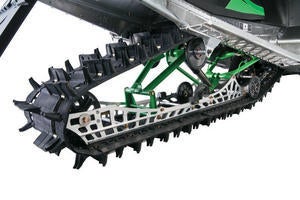 An all-new PowderClaw track combines the best features of two previous Cat designs.
An all-new PowderClaw track combines the best features of two previous Cat designs.
There’s a new track. The PowerClaw is a joint effort between Arctic Cat and track maker Camoplast. It combines rubber fingers with the ‘cupping’ effect of a paddle. The result is a track that works well on the trails getting to the powder and provides exceptional snow-ability performance once there. There are two versions, a 153-inch and a 162-incher with 2.5-inch paddle length.
There are various engine choices including the 600cc Suzuki-built twin, but we’d guess serious powder hounds will go all out with the one-liter 2-stroke in the M1000 configuration. Measuring 999cc, this top-of-the-line 2-stroke features the precision starting and running of a batteryless electronic fuel injection system, which is handy in the rarified air of the mountains. There’s a standard exhaust pipe temperature sensor and electronically controlled exhaust valves. All designed to maximize this Cat’s mountain snow efficiency.
As with all manufacturers, there are special incentives for choosing your mountain ride early. Cat’s M-Series comes in a ‘spring only’ LE version with special graphics and other goodies that you should ask about at your local dealership.
Attitude & Altitude
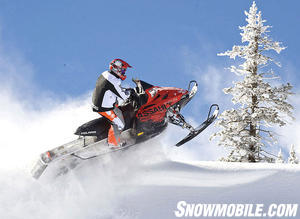 Polaris caters to the extreme powder rider with the new Assault.
Polaris caters to the extreme powder rider with the new Assault.
If you think Arctic Cat got serious about maximum mountain performance, just visit a Polaris dealer. The folks from Roseau, Minn., where it’s really, really flat, actually know quite a bit about making sleds for the steep and deep set. That RMK designation of the longest tracked Polaris models not too modestly stands for Rocky Mountain King. For 2009 Polaris tops the charts with nine RMK models.
This company has long worked with select western dealerships to gather input about just what western riders need. In fact, one of Polaris’ past product planners came out of a western dealership and was an accomplished mountain rider himself. His influences on the deep snow product continue as Polaris engineering diligently works to reduce weight and add power. But while Polaris’ 800 Dragon RMK 163 is competition for Arctic Cat’s top M-Series model, Polaris establishes a new, more extreme direction.
The 2009 Polaris 800 Assault RMK makes no pretense. It is a high-powered, lightweight model aimed at giving the extreme backcountry enthusiast a way to express more attitude than ever before. These riders are all attitude and altitude. They are lean and limber riders who challenge the downside of a western cornice without fear. They have usually custom-built their powder sleds to suit their personal style. Polaris listened and seems to have learned. The Assault is the result.
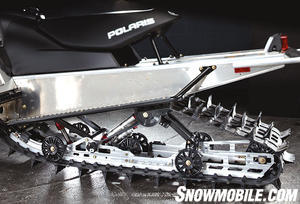 Everything has a function on the Assault; note the toughened-up rear skidframe and minimalist Freestyle seat.
Everything has a function on the Assault; note the toughened-up rear skidframe and minimalist Freestyle seat.
Power is Polaris’ 795cc 2-stroke twin, said to deliver more than 150 horsepower. An electronic reverse is standard and a boon to unloading this 126-inch long sled.
While Polaris could have opted for a longer track, the Assault manages with an efficient 146-inch long by 15-inch wide unit that allows extreme backcountry riders to maneuver quickly. The Assault is not so much a highmarking sled as it is the ultimate boondocking machine for extreme riders.
Polaris’ Assault should stand out in the backcountry with its matte red cowl, naked aluminum chassis and blackout windscreen. Its Freestyle seat tapers narrow at the front and widens to the rear to allow the rider to dance around powder berms.
Of course, the Polaris Assault should stand out simply because those who demand this sled will seek raw power to showcase their naked ambition and ability to scour the back country that others fear to tread.
Born in the Rockies
Engine Type:Horizontal In-line
Cylinders:2
Engine Stroke:2-Stroke
Valve Configuration:Reed Valve
Displacement:999 / 61
Starter:Electric
Turbocharged:No
View Full Spec
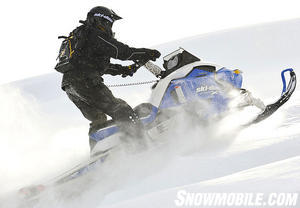 Ski-Doo’s Summit X has one of the best power-to-weight ratios in the powder segment.
Ski-Doo’s Summit X has one of the best power-to-weight ratios in the powder segment.
The 2009 Ski-Doo Summit X is an early order choice that combines the latest REV-XP chassis with an 800cc Rotax Power Tek. Add in mountain-specific features and you have serious competition for both Arctic Cat’s M-Series and Polaris RMKs.
These current model Summits owe a great deal to Ski-Doo’s creating a ‘mountain’ division test site. Previously operating out of the Denver, CO area, the current sleds are fine-tuned in the Grand Lake area northwest of Denver, near the western fringes of Rocky Mountain National Park. With elevations ranging from 8,000 feet to 12,000-feet, the Grand Lake area has proven handy for testing other BRP products, including Can-Am ATVs, Sea-Doo watercraft and the new Can-Am Spyder. But it is the Ski-Doo Summit that has gained the most from this high mountain test area.
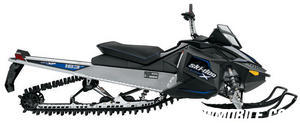 You can get the blue and white “X” or opt for a black version of Ski-Doo’s Summit X.
You can get the blue and white “X” or opt for a black version of Ski-Doo’s Summit X.
The ‘X’ package, available to early buyers, comes with lighter weight components than the in-season Summit models. There are take-apart, aluminum-bodied Kayaba front shocks; a special low windshield; a racing-style lightweight seat; and racing-inspired brake components of braided line and Ferrit brake pad. Special bright blue and white or deep black graphic packages highlight the ‘X’ selection.
With a claimed power-to-weight ratio of less than three pounds per horsepower, the Summit should be easy to manhandle in the mountains. Like the competition, the Summit features anti-slip runningboards with lipped edges to keep your boots in place. There’s a deep lug patterned PowderMax track designed to make the sled grip and glide through and over the powder.
While this model is mostly an upgrade from the previous season, the 2009 Summit X with 163-inch track will compete head-to-head with the competition. It was born in the Rockies to let Ski-Doo riders make their mark high on the slopes.
Choices
What choices are there for the most serious of powder hounds? Cat riders will like what the Thief River Falls, MN folks have done to the M-Series for 2009. Less weight, new rider-friendly features and a new track design means increased mountain-ability.
Polaris riders can order an RMK with the power and track to challenge the M-Series, but Polaris believes that more riders, especially those who are not vertically challenged, will opt for the extreme thrill of banking off cornices, dropping over rock faces and exploring where no else has been. Polaris’ Assault is their answer, but is not for the timid.
Ski-Doo’s Summit X was born and bred in the Rockies. It has the power of an 800cc 2-stroke twin and the traction of a 163-inch track to take its riders to new heights.
But, which is best? Hey, we’ll admit it; our days of riding the steep and deep have long since passed. Frankly it passed when we had to dig ourselves out of mountain hillsides in oxygen-depleted air one too many times. The prospect of being stuck in bottomless snow is not that appealing to this flatlander. But we can appreciate and applaud the ballet of a truly accomplished deep-snow rider highmarking a mountainside on a bright blue-sky day.
In our estimation, any of these three sleds will allow a truly gifted powder rider to stake claim to a highmark anywhere, anytime. If you want to bust powder on Frisbee Ridge in Revelstoke, BC or simply bust the bottom of a cornice at Little Chicken in Grand Lake, Colo., any of these three choices can make your day.
Related Reading:
2009 Polaris Preview
2009 Arctic Cat preview
2009 Ski-Doo preview
Specs:
2009 Arctic Cat M1000 EFI 162 Sno Pro
2009 Polaris RMK® 800 Assault (146-inch)



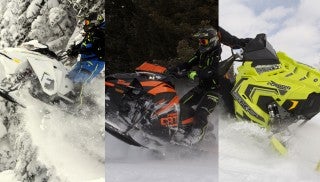

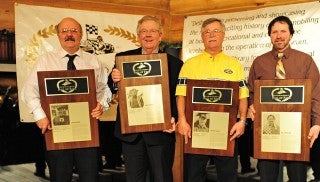


 Your Privacy Choices
Your Privacy Choices